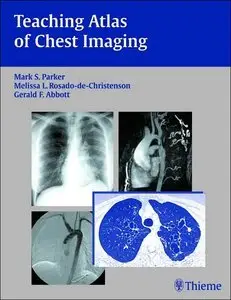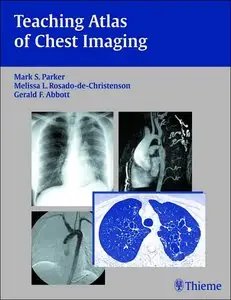Teaching Atlas of Chest Imaging by Mark S. Parker, Melissa L. Rosado-de-Christenson and Gerald F. Abbott
English | 2005-12-14 | ISBN: 1588902307 | 800 pages | scan PDF | 52 MB
English | 2005-12-14 | ISBN: 1588902307 | 800 pages | scan PDF | 52 MB
This lavishly illustrated book is your comprehensive, hands-on guide to evaluating chest images. It is ideal for reading cover-to-cover, or as a reference of radiological presentations for common thoracic disorders. With this book, you will learn to interpret chest images and recognize the imaging findings, generate an appropriate differential diagnosis, and understand the underlying disease process.
The atlas begins with a review of normal thoracic radiography, CT, and MR anatomy, and goes on to present cases on a wide range of congenital, traumatic, and acquired thoracic conditions. Each case is supported by a discussion of etiology, pathology, imaging findings, treatment, and prognosis in a concise, bullet format to give you a complete clinical overview of each disorder. More than 1,050 high-quality images demonstrate normal and pathologic findings, and complementary scans demonstrate additional imaging manifestations of disease entities.
Residents, fellows, and general radiologists called upon to interpret chest images will find this easy-to-use book invaluable as a learning tool and reference. It is also a must for thoracic radiologists, pulmonary physicians, and thoracic surgeons who must read chest images –especially of challenging cases.
"A valuable text for any imaging department's library or as an easily accessible desktop reference in the clinical setting."–The Radiographer
"Teaching Atlas of Chest Imaging presents nearly 200 well-illustrated cases in a case-based format that is optimized for self-assessment. ..After using this textbook–one that you'll actually want to read–I am convinced that the reader's diagnostic confidence in interpreting everyday chest imaging will increase at the reviewing station. I enthusiastically recommend this textbook for any general radiologist who is involved in any form of chest or pulmonary imaging; all radiology residents, but particularly those preparing for oral boards; pulmonologists; and anyone wishing to maintain certification."–American Journal of Roentgenology
"An eminently readable text that provides content related to the important categories of chest disease through a series of well-illustrated, case-based material. Especially helpdful features include "pearls" and "pitfalls" pertinent to each disease. Each case discussion concludes with an excellent up-to-date list of suggested reading. The quality of the imaging figures is excellent. Overall, this book is a complete, hands-on guide to evaluating chest disease. It is ideal for reading cover-to-cover or as an illustrated reference of radiologic manifestations of common thoracic disorders. Radiology residents, thoracic imaging fellows, and practicing general radiologists (especially those involved in the process of maintaining certification) will find this easy-to-use book a valuable tool and reference. [The book] should also be considered a key resource for pulmonary and critical care medicine physicians, thoracic surgeons, and all interested in chest disease. With Teaching Atlas of Chest Imaging, readers should be able to expand their chest-imaging interpretation skills, learn to recognize abnormal findings, generate appropriate differential diagnoses, and better understand the underlying disease process. The content is comprehensive and rigorous. The case material is excellent. I highly recommended the Teaching Atlas of Chest Imaging as a valuable addition to departmental and personal libraries of all those who share an interest in chest disease."–Respiratory Care
"Each discussion is complete, up-to-date and represents a vade mecum which would be useful not only to radiologists, but also to pulmonary physicians and thoracic surgeons. The chapters end with appreciated "bulleted pearls" and "bulleted pitfalls," where the more typical diagnostic points are emphasized. This didactic formula in bulleted format is based on the use of a concise text without losing its completeness. This atlas is complete, well organized and enriched by numerous clear illustrations. Its strength is in its usefulness when the reader, preparing a report, needs a rapid diagnostic consultation, proposing epidemiologic, clinical, therapeutic and anatomic pathologic information. The book is recommended to the more expert chest radiologists as a useful manual when in need of refreshing clinical and pathologic information, which is not always fresh in the memory, to the senior residents who may be called to read challenging chest images, and it would be useful also to the pulmonary specialist and the thoracic surgeon facing a difficult pulmonary problem."–Clinical Imaging



